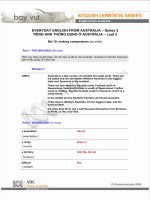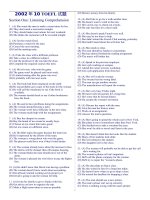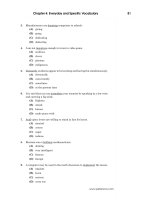TOEFL 2002 2 10
Bạn đang xem bản rút gọn của tài liệu. Xem và tải ngay bản đầy đủ của tài liệu tại đây (133.11 KB, 13 trang )
2002 年 10 TOEFL 年年
Section One: Listening
Comprehension
1. (A) She wants the man to make a reservation for her.
(B) They don't need a reservation tonight.
(C) They should make reservations for next weekend.
(D) She thinks the restaurant will be crowded tonight.
2. (A) Get her watch fixed.
(B) Purchase a watch for the man.
(C) Cancel the next meeting.
(D) End the meeting early.
3 (A) Take the class with a different professor
(B) Take a class in a different subject.
(C) Ask the professor if she can take the class.
(D) Complete the required courses this term.
4. (A) He isn't sure who won the game.
(B) The game won't be played until next week.
(C) It started raining after the game was over.
(D) It probably will rain next week.
5. (A) The book had been misplaced on the shelf.
(B) He can probably get a copy of the book for the
woman.
(C) He will call the warehouse to see if the book is
available.
(D) The woman should check to see if other bookstores
have the book..
6. (A) He used to have problems doing the
assignments.
(B) The woman should become a tutor.
(C) The woman won't have difficulty in her next class.
(D) The woman needs help with her assignments.
7. (A) Buy the cheaper ice cream.
(B) Buy the brand of ice cream he usually buys.
(C) Choose an ice cream that tastes good.
(D) Get ice cream at a different store.
8. (A) He didn't enjoy the game because the team lost.
(B) He's impressed by the efforts of the team.
(C) The woman is wrong about who won the game.
(D) The players could have won if they'd tried harder.
9. (A) The woman already knew about the increase in
fees.
(B) The dorms will be cheaper than off-campus
housing.
(C) The woman thinks the man should move out of the
dorm.
(D) The woman is pleased she won't have to pay the
higher fees.
10. (A) He didn't know that David was having a
problem.
(B) The woman doesn't know much about accounting.
(C) David hasn't started working on his project yet.
(D) David is going to ask the woman for help.
11. (A) Invite his family to go to Alaska with him.
(B) Get advice on how to organize the trip.
(C) Make a flight reservation as soon as possible.
(D) Borrow money from his family.
12. (A) He'd like to go for a walk another time.
(B) He doesn't want to walk in the rain.
(C) He's on his way to check out a book..
(D) He only has time for a short walk.
13. (A) She doesn't speak French very well.
(B) She may be too busy to help.
1(C) She didn't attend the French Club meeting
yesterday.
2(D) She hadn't heard about the activities fair.
14. (A) She needs to relax.
(B) The man should try harder to concentrate.
(C) She has almost finished the reading assignment.
(D) The music will bother her.
15. (A) Speak to his previous employer.
(B) Get a job working on campus.
(C) Attend the career services workshop.
(D) Get a job application form from her.
16. (A) She will wash the sweater.
(B) The sweater has the wrong label.
(C) The man can get another sweater.
(D) The manufacturer will repair the sweater.
17. (A) He's very busy Friday night.
(B) He hasn't seen his parents for a long time.
(C) He's sorry that he missed dinner.
(D) He accepts the woman's invitation.
18. (A) Discuss her report with the man.
(B) Give the man her history notes.
(C) Work on an assignment.
(D) Answer the man's questions.
19. (A) She's going to spend the whole year in New
York.
(B) She plans to travel somewhere other than New
York.
(C) She decided not to take a vacation this year.
(D) She won't be able to travel until later in the year.
20. (A) She doesn't think that she looks like the student.
1
(B) Many of her students look alike.
(C) She isn't related to the student.
(D) Her daughter isn't in her class.
21. (A) The woman will probably not be able to get the
call she's waiting for.
(B) The woman's phone call isn't important.
(C) He'll call the phone company for the woman.
(D) He'll try to repair the "woman's phone.
22. (A) He also plans to drop a class.
(B) He also waited in line for a long time today.
(C) He doesn't know where to go to drop a class.
(D) He missed the deadline for dropping a class.
23. (A) The man should use a new printer.
(B) The man's primer isn't set up correctly.
(C) There is nothing wrong with the man's printer.
(D) She can't help the man right away.
24. (A) The woman should wear his scarf to the game.
(B) It will be cold at the game.
(C) The woman should borrow another sweater.
(D) He'll go home and get another scarf.
25. (A) She understands why the man seems unhappy.
(B) She will help the man change his diet.
(C) The man should see a doctor.
(D) The doctor has already explained the problem to
her.
26. (A) The number of people who voted was very low.
(B) The vote was very close.
(C) Congressman Baker didn't run for office.
(D) She was not pleased with the results.
27. (A) He's sorry that the woman didn't like the book.
(B) He can order the math book for the woman.
(C) It's too late for the woman to get a refund.
(D) The woman bought the book less than ten days ago.
28. (A) He was pleased with the art in the collection.
(B) He prefers small art exhibits to large ones.
(C) He hasn't visited the art gallery yet.
(D) He doesn't enjoy going to art galleries.
29. (A) He'd like to invite the woman for lunch..
(B) He didn't expect to join the woman for lunch.
(C) He can help the woman solve the math problem.
(D) He wants to postpone his lunch meeting with the
woman.
30. (A) Vote for the man.
(B) Read the man's speech.
(C) Introduce the man to the class president.
(D) Tell her friends to vote in the election.
31. (A) The early history of bookbinding.
(B) How old books become valuable.
(C) Economical ways to protect old books.
(D) Why some books deteriorate. .
32. (A) They are often handled improperly by readers.
(B) The paper is destroyed by chemicals.
(C) The ink used in printing damages the paper.
(D) The glue used in the binding loses its strength.
33. (A) They are difficult to read.
(B) They are slowly falling apart.
(C) They were not made from wood pulp.
(D) They should be stored in a cold place.
34. (A) It's very expensive.
(B) It hasn't proven to be totally effective.
(C) It can be damaging to some books.
(D) It can't be used on books published before 1850.
35. (A) Get some books for the man to look at.
(B) Ask the man to look over her notes.
(C) Continue her research in the library.
(D) Find more information on how books are
preserved.
36. (A) To plan an exhibit of the student's artwork.
(B) To discuss different whaling techniques.
(C) To prepare for a visit to a museum.
(D) To review information for an examination.
37. (A) Iron from old ships.
(B) Wood found floating in the ocean.
(C) Seashells of unusual shapes and colors.
(D) The bones and teeth of whales.
38. (A) To occupy their free time.
(B) To bring good luck.
(C) To earn extra money.
(D) To take part in art competitions.
39. (A) They were used in the home.
(B) They were used to decorate the ship.
(C) They were used to catch whales.
(D) They were sold to art dealers.
40. (A) The importance of anthropology to modern
society,
(B) A good source of information about a society.
(C) Attitudes toward culture in the 1940's.
(D) The relationship between anthropology and the
military.
41. (A) Students might not consider them to be an
important part of culture.
(B) They symbolize the rebellion of youth in the
1950's.
2
(C) They are discussed in the student's textbook.
(D) They have been worn for hundreds of years.
42. (A) To show how politics have changed over the
years.
(B) To point out that T-shirts often provide personal
information.
(C) To illustrate how the printing on clothing has
improved.
(D) To support that T-shirts are a form of art.
43. (A) Places where T-shirts are not acceptable.
(B) Images that are currently printed on T-shirts.
(C) Names of people who have made T-shirts popular.
(D) Ways that T-shirts represent American culture.
44. (A) Successful business practices.
(B) Famous inventors.
(C) Public health concerns.
(D) Unsuccessful inventions.
45. (A) They drank from public water fountains.
(B) They passed around a cup of water.
(C) They drank from personal tin cups that they carried
with them.
(D) They bought a paper cup of water.
46. (A) To demonstrate the importance of public health
laws.
(B) To point out that without luck businesses will not
succeed.
(C) To explain how traveling led to new inventions.
(D) To illustrate the importance of having the right
product at the right time.
47. (A) How grasshoppers find food.
(B) How grasshoppers fight other insects.
(C) How grasshoppers communicate with each other.
(D) How grasshoppers escape from danger.
48. (A) To correct a common misunderstanding about
grasshoppers.
(B) To help explain how well grasshoppers can jump.
(C) To compare the size of grasshopper with that of
other insects. -
(D) To show how quickly grasshoppers respond to
danger.
49. (A) They detect nerve impulses transmitted to a
grasshopper's legs.
(B) They sense how far a grasshopper has jumped.
(C) They detect changes in air pressure.
(D) They help a grasshopper find food.
50. (A) The number of impulses transmitted to the
grasshopper's legs.
(B) The age of the grasshopper.
(C) The number of sensory organs the grasshopper has.
(D) The size of the nerves that control walking.
3
Section Two: Structure and Written Expression
1. Among the 450 artworks in the White House
art collection __ .
(A) as is Mary Cassatt's Young Mother and Two
Children
(B) is Mary Cassatt's Young Mother and Two
Children
(C) which is Mary Cassatt's Young Mother and
Two Children
(D) Mary Cassatt's Young Mother and Two
Children
2. An unconsolidated aggregate of silt particles
is also termed silt, _____ a consolidated
aggregate is called siltstone.
(A) which
(B) why
(C) whereas
(D) whether
3. In 1864 the American Shakespearean actor
Edwin Booth gained critical acclaim when he
____ Hamlet at the Winter Garden Theatre in
New York City.
(A) perform
(B) performed
(C) had been performing
(D) having performed
4. ____ are chiefly derived from petroleum.
(A) Plastics today
(B) There are plastics today
(C) Because today plastics today
(D) Due to plastics today
5. Most tangerine trees and their flowers and
fruits resemble ____the orange, although
tangerines are generally smaller.
(A) of those
(B) which of those
(C) those of (D) which are
of
16. Ohio, the center of_____ the Hopewell
culture, has the greatest concentration of ancient
burial mounds in the United States.
(A) called
(B) what is called
(C) that is called
(D) is called
7. ____ , such as jazz, are often played from
memory rather than from a written score.
(A) Of some types music
(B) Music some of types
(C) Some types of music
(D) Types of music some
8. During the 1850', reform movements
___temperance and the abolition of slavery
gained strength in the United States.
(A) advocating
(B) they had advocated
(C) to advocating
(D) to advocate when
9. Many meteorites are thought to have
originated from ___ that once existed between
the orbits of Mars and Jupiter.
(A) where a planet or planets
(B) a planet or planets so
(C) which a planet or planets
(D) a planet or planets
10. The modern automobile is a
composed of more than 14,000 parts.
(A) complex technical system
(B) system of complex technical
(C) complex technical system that
(D) system is technically complex
11. over 100 years since the invention of
the square-bottomed paper bag.
(A) Now is
(B) Now it has
(C) There is now
(D) It is now
12. The novelist John Dos Passes developed a
style of fiction incorporating several
documentary devices ____ to his works.
(A) lent realism
(B) that lending realism
(C) to lend realism
(D) of whose realism lent
13. In Earth's infancy, its surface was warm
enough for life ____ the young Sun
was fainter than it is today.
(A) in spite of
(B) whether
(C) neither of which
(D) even though
114. The invention of the compound
microscope (which allowed much higher
magnification through multiple lenses)
made _____ the great strides in life
sciences.
(A) it possible
(B) possibly
(C) possible
(D) it was possible
15. Hares generally have longer ears and hind
legs than rabbits and move by jumping
____ running.
(A) rather to be
(B) rather than
(C) are rather
(D) as rather
16. Lake trout, fish usually finding in deep, cool lakes, are greenish gray and are
A B
covered with pale spots.
C D
17. During the first 20 years of the space age, the United States spent more than 90
A B
billion dollars onto its civilian and military space programs.
C D
118. Vitamins A and C and most of the B vitamins are retain in foods that have
A B C
been canned.
D
19. Ella Baker spent her adult life working for social change by lecturing, writing,
A B
teacher, and organizing adult literacy programs.
C D
20. Gold can combined with silver in any proportion, but alloys with 50 to 60 percent
A B C
silver are the_strongest.
D
21. The camera obscura, a lensless precursor of the photographic camera, consists_of
A
a darkened chamber, with light pass into it through a single tiny hole.
B C D
22. Lumber production was the main industry in Michigan until the early 1900's,
A B C
which the automobile industry was established in Detroit.
D
23. Twenty minutes of vigorous exercise every day is very effect in helping a person
A B C
to maintain physical fitness.
D
24. It was not until after Emily Dickinson's death in 1886 that, hidden away in her
A B
bureau, overly one thousand unpublished poems were discovered,
C D
25. Rocks form within Earth are called intrusive or plutonic rocks because the
A B









